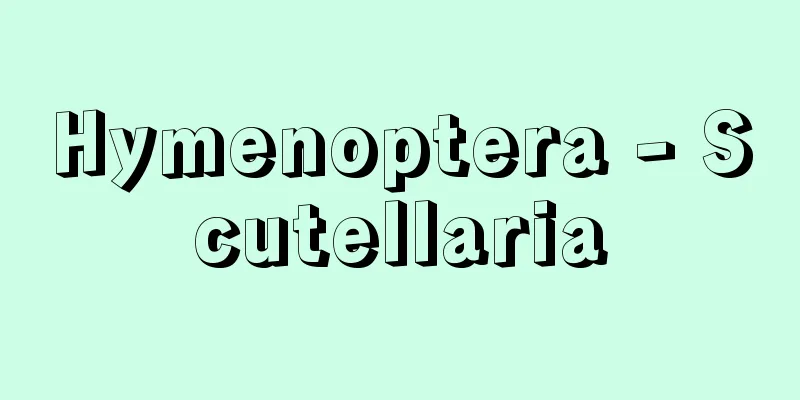Hymenoptera - Scutellaria

|
They are a group of insects in the order Hymenoptera, the second most diverse after the beetles (Coleoptera). They are related to bees and ants, and there are more than 100,000 known species worldwide. However, if the classification of the tiny parasitic wasps (body length 0.5 to 1.5 mm) progresses further, it is estimated that they will become the largest group in the living kingdom. Morphologically, the distinction between the head, thorax and abdomen is extremely clear, the two pairs of membranous wings are well developed, and the hind wings are always smaller than the forewings. The wing veins are degenerate, and sometimes wingless bees (mostly females) are present. Higher bees, such as honeybees, are the most functional fliers in the living world. The mouthparts are of the biting type, and some types (bees) have the added function of sucking. The female's ovipositor is saw-like in sawflies, cutting open plant tissue, a drill in parasitic wasps, and a stinger in hunting wasps and flower wasps, which is used to anesthetize prey, and for attack and defense (male wasps do not sting). They are classified into two suborders, and generally, the Symphyta (sawflies, wood wasps, etc.; their larvae have legs) are herbivorous, while the Scleractinia (ichneumonids, ants, hornets, etc.; their larvae are legless) are carnivorous. However, bees have reverted to feeding on plants (pollen and nectar). Unlike the Symphyta, the Scleractinian has fused the first abdominal muscle to the thorax, and there is a strong constriction between the thorax and abdomen (actually the base of the second abdominal segment). This gives the abdomen mobility and allows the stinger at the end of the abdomen to be used freely. Their feeding habits and ecology are also extremely diverse, including wood wasps that bore holes into the wood of conifers, sawflies that damage leaves, gall wasps that create galls on plants, eggs, larvae, and pupae of other insects, and occasionally parasitic wasps (parasitic wasps) that parasitize and kill adult insects, including ichneumons, braconid wasps, small wasps, and ground wasps, some of which are secondary and tertiary parasites. There are hunting wasps (such as mud wasps, hornets, and digger wasps) that hunt and store moth larvae to feed their young, and bees (flower wasps) that visit flowers to collect and transport pollen and nectar to feed their young. The evolution of their lifestyles, habits, and instincts is remarkable. Many wasps build magnificent nests, and all ants, some of the hornets, and most of the bees lead highly social lives. Development is complete, and many pupae are housed in cocoons. Reproduction is sexual, with males and females being heteromorphic. Some species, such as the chestnut gall wasp, reproduce only with females (parthenogenesis), while some other gall wasp species have alternating generations, and some entchygeranium species reproduce polyembryonically. In bees, eggs laid always develop, with fertilized eggs becoming female bees (queen bees and worker bees in honeybees), and unfertilized eggs becoming male bees. The relationship between bees and human life is particularly deep, and with the exception of some agricultural and forestry pests and sanitary pests, the majority are beneficial insects, helping to transmit pollen and exterminate harmful insects. Beekeeping is popular all over the world. In Japan, pea bees (megachilidae) are used to transmit apple pollination. Some parasitic wasps that kill pests are used as biological pesticides. Honeybees, which are sometimes feared because they sting people, are used to treat rheumatism. [Yoshihiro Hirashima] Source: Shogakukan Encyclopedia Nipponica About Encyclopedia Nipponica Information | Legend |
|
昆虫綱の一目Hymenopteraで、甲虫類(鞘翅(しょうし)類)に次いで種類の多い一群。ハチとアリの仲間で、世界中で10万種以上が知られているが、微小な寄生バチ類(体長0.5~1.5ミリ)の分類がさらに進めば、生物界最大の群になると推定されている。 形態的には頭、胸、腹部の区別がきわめて明瞭(めいりょう)で、二対の膜質のはねはよく発達し、後翅はつねに前翅より小さい。翅脈は退化的で、ときに無翅のハチ(雌に多い)もいる。高等なハチ、たとえばミツバチなどは生物界で最高の機能をもつ飛行家である。口器はかむ型で、これに吸う機能を加えた型(ハナバチ類)もある。雌の産卵管はハバチ類では鋸(のこぎり)式となって植物組織を切り開き、寄生バチ類ではドリルとなって穿孔(せんこう)し、狩りバチや花バチでは刺針となって獲物の麻酔、攻撃と防御などに用いられる(雄バチは刺さない)。 次の二亜目に分類され、原則的に広腰亜目(ハバチ、キバチほか。幼虫は有脚)は植物食性、細腰亜目(ヒメバチ、アリ、スズメバチほか。幼虫は無脚)は動物食性である。ただし、ハナバチ類は先祖返りをして植物(花粉・花蜜(かみつ))食性となった。細腰亜目は広腰亜目とは違って腹部第一筋が胸部に融合するとともに、胸部と腹部の間(実は腹部第二節の基部)が強くくびれている。これによって腹部の運動性を獲得し、腹端の刺針を自在に使用することができるようになった。 食性と生態も実に多様で、針葉樹の材中に穿孔侵入するキバチ、葉を食害するハバチ、植物体に虫こぶをつくるタマバチ、ほかの昆虫の卵、幼虫、蛹(さなぎ)、まれに成虫に寄生してこれを食い殺すヤドリバチ類(寄生バチ)にヒメバチ、コマユバチ、コバチ、ツチバチほかがあり、このなかには二次寄生、三次寄生をするものもある。ガの幼虫などを狩って蓄え自分の子の食餌(しょくじ)とする狩りバチ(ドロバチ、スズメバチ、ジガバチほか)、訪花して花粉や花蜜を採取・運搬して子を養うハナバチ類(花バチ)など、生活様式・習性と本能の進化は目を見張るものがある。多くのハチはみごとな巣をつくり、アリの全部、スズメバチ科の一部、ミツバチ科の大半は高度な社会生活を送る。 発生は完全変態で、蛹は繭に収まるものも多い。繁殖は有性生殖で、雌雄は異型。クリタマバチなどは雌ばかりで繁殖(単為生殖)し、ほかのタマバチのある種は世代交代をし、トビコバチには多胚(たはい)生殖をするものもある。ハチでは産み落とされた卵はつねに発生し、受精卵は雌バチ(ミツバチでは女王バチと働きバチ)に、不受精卵は雄バチになる。 ハチと人間生活との関係はとくに深く、一部の農林害虫や衛生害虫を除けば大半が益虫で、花粉の媒介や害虫の駆除に役だつ。養蜂(ようほう)業は世界各地で盛んに行われている。日本ではリンゴの花粉媒介にマメコバチ(ハキリバチ科)が利用されている。害虫を倒す寄生バチのなかには生物農薬として利用されているものもある。人を刺すのでときに恐れられるミツバチは、リウマチの治療に用いられている。 [平嶋義宏] 出典 小学館 日本大百科全書(ニッポニカ)日本大百科全書(ニッポニカ)について 情報 | 凡例 |
>>: Membrane Integrated Circuit
Recommend
al-`Utbī, Abū Naṣr Muḥammad
[Raw]? Ray [Died] 1035/1036 Iranian historian. He ...
Fort Lauderdale
A resort and tourist city in southeastern Florida,...
Umenokigoke - Umenokigoke
A representative species of the Parmeliaceae lich...
Tartar
...It is said that there were many Tatars in this...
Base material - Soji
〘 noun 〙 (also "sochi") 1. The original ...
Kalyani - Kalyani
…It was a dynasty that ruled over the Deccan regi...
Kung Ye
[raw]? [Died] King Keimyō 2 (918) King Taebong of ...
Objection - Igimoshitate
A type of appeal against an administrative agency...
Roundworm pneumonia - roundworm pneumonia
...No larvae form in unfertilized eggs. [Ascarias...
Isis
… The works of G. Sarton, who was born in Belgium...
Wu Tingfang (English: Wǔ Tíng fāng)
1842‐1922 A modern Chinese politician and diplomat...
The benefits of collaboration
…Cooperation and division of labor in factories a...
Uchigumorito
…His Buddhist name was Jisshoin Ensai Soin Koji. ...
Kaishisui - Kaishisui
…The 105th day after the winter solstice is calle...
Lake Nojiri - Nojiriko
This lake is located in Shinanomachi, Kamiminochi...






![West Highland white terrier [breed] (English spelling)](/upload/images/67caf9d74b1d6.webp)


